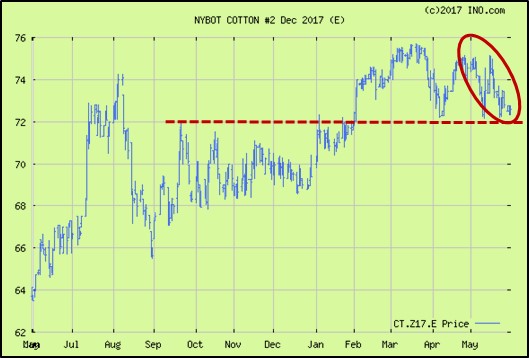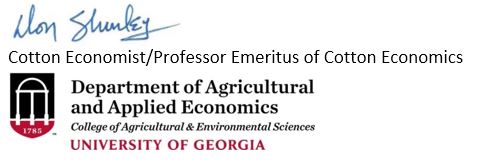 According to the latest USDA Crop Progress report, the US cotton crop was 63 percent planted as of May 28th—essentially at the average for that date. In the Southeast, planting progress is at a normal level with exception of North Carolina and Virginia being behind 10-12 percentage points. In the Mid-South, planting is mostly ahead of normal with exception of Missouri being behind 7 points. Texas was at 52% planted (normal) but squaring normal. California was 72% planted compared to 96% normal.
According to the latest USDA Crop Progress report, the US cotton crop was 63 percent planted as of May 28th—essentially at the average for that date. In the Southeast, planting progress is at a normal level with exception of North Carolina and Virginia being behind 10-12 percentage points. In the Mid-South, planting is mostly ahead of normal with exception of Missouri being behind 7 points. Texas was at 52% planted (normal) but squaring normal. California was 72% planted compared to 96% normal.
As we proceed to complete planting and get fully into the growing season, growers will be looking for and accessing marketing opportunities to price or in some fashion take protection on some portion of expected production. I believe some growers are already quite a good ways along in their marketing; some are not. In either case, evaluating the outlook and making price risk management decisions will be crucial.  Prices have taken a weaker, more cautious tone in recent weeks. This is clearly seen looking at the December futures chart. At least for the present, it looks like there is good “support” at 72 cents. Further, the upper limit or “resistance” is at roughly 75 cents. In other words, given the forces and supply/demand factors as we think we know them at present, prices seem comfortable or likely to range between roughly 72 and 75 cents.
Prices have taken a weaker, more cautious tone in recent weeks. This is clearly seen looking at the December futures chart. At least for the present, it looks like there is good “support” at 72 cents. Further, the upper limit or “resistance” is at roughly 75 cents. In other words, given the forces and supply/demand factors as we think we know them at present, prices seem comfortable or likely to range between roughly 72 and 75 cents.
So, what are these “forces” and what will the market be keying on as we look and plan ahead? As growers consider further pricing opportunities, what can impact the direction prices take?
First of all, let’s acknowledge that we have seen 2016 crop futures increase from the 70-cent area last Fall to 80 cents or better more recently. So, when making 2017 crop pricing decisions, it could be difficult for the grower to get that 80 cents out of his/her mind as a target for the new crop.
Is 80 cents possible for the 2017 crop? Anything is possible because supply, demand, and policy factors are unknown and highly variable. I can also draw you a scenario for 68 cents. The more pertinent question might be at what price do you think it’s worth beginning to take protection and reduce the risk of getting something lower?
The following are some, but not all, of the factors that will come into play over the remainder of the growing season:
- US Acres and Crop. The 2017 US crop is currently estimated by USDA at 19.2 million acres based on planting intentions of 12.23 million acres (Mar 31). Change in cotton prices since that time are not likely enough to influence plantings but an increase in plantings or likely crop size could weaken prices.
- US and ROW Ending Stocks. Stocks on hand in the US at the end of the 2017 marketing year are projected to increase by 1.8 million bales. If the crop is bigger than currently projected, that number could grow. But, stocks in the rest of the World (ROW) are projected to decline by over 4 million bales.
- China Continues to Reduce Stocks. China’s cotton production is expected to increase 3% this year. Its mill use of cotton is forecast to increase by ½ million bales. Use will be 14 million bales more than production—deduct 5 million bales of imports and the result is a 9 million bale reduction in stocks.
- World Use Improving. World Use is forecast at 115.75 million bales—a 2.25% increase from the ‘16 crop marketing year. If we are to sustain the current level of prices and higher, the big unknown is at what price will it begin to impact the use of cotton in mills and the substitution of manmade fibers?
- US Exports. Exports for the ’17 crop year are forecast down ½ million bales from the ’16 crop year but still at a very good level. With a larger US crop possible, exports must remain strong. Cancellations of 2016 crop export sales could push purchases into the 2017 crop year.
There’s optimism within the cotton industry right now and rightfully so. There are some policy challenges to be addressed but demand is improving, stocks are declining, and prices have a chance to be relatively “good” for the second year in a row and perhaps longer. Evaluate 2017 marketing alternatives carefully to both achieve your price goals and also manage risk.
- Friday Feature:American Agriculture is Losing the Trade War in the Food Commodity Export Market - October 31, 2025
- Friday Feature:Ford Farms Featured on Local News Story about Peanuts - October 24, 2025
- September 2025 Weather Summary and Last Quarter Outlook - October 10, 2025


